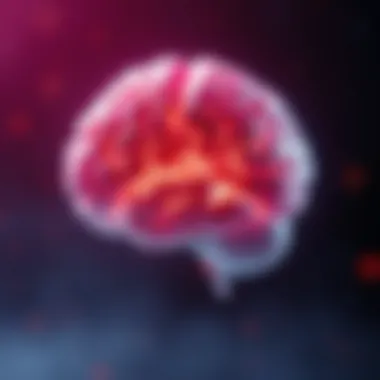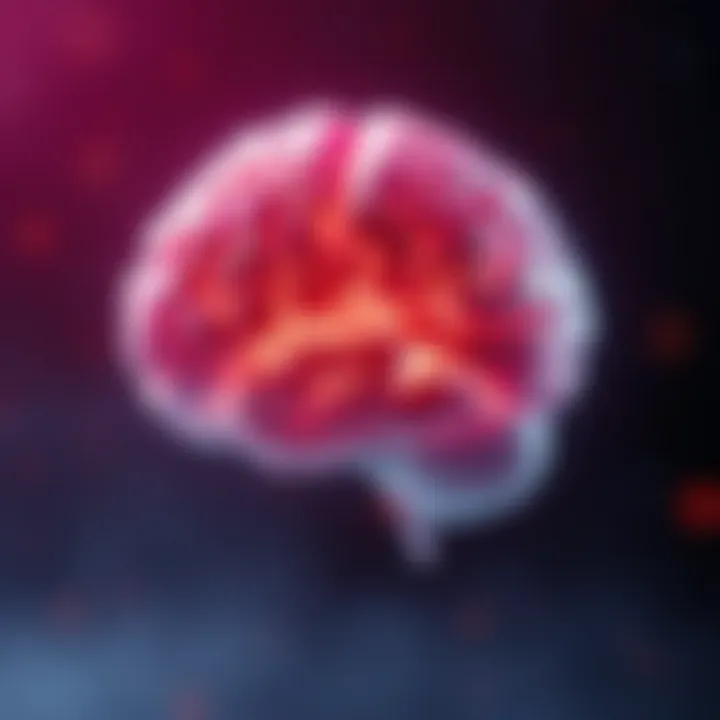Navigating Anxiety's Influence on Focus


Intro
Anxiety has become a buzzword in modern society, echoing in conversations from coffee shops to corporate boardrooms. The relationship between anxiety and concentration is particularly relevant today, especially when many individuals find themselves pressed for time and under pressure. As we navigate this intricate web, it becomes crucial to understand how anxiety can scramble one's ability to focus. This section provides insight into the prevalent issue, outlining its significance in both personal and work settings.
Thinking about anxiety, imagine a tightrope walker trying to balance with a gusty wind at their back. As they sway, maintaining concentration becomes a Herculean task. Similarly, individuals facing anxiety often struggle to keep their cognitive gears running smoothly when pressure mounts. This article aims to peel back the layers surrounding this connection and provide solid strategies for managing anxiety's impact on focus. In a world that prizes productivity, understanding this relationship is not just helpful; it's vital.
The exploration of this topic extends beyond mere academic curiosity. For professionals, recognizing the signs of anxiety and its consequences can catalyze personal and organizational growth. Collectively, we can encourage work environments that are not only supportive but also conducive to maintaining both mental clarity and emotional resilience.
Now, let’s plunge deeper into the heart of this exploration.
Prolusion to Anxiety and Concentration
Anxiety is a familiar term, yet its implications can be deeply complex. It's not merely feeling nervous or worried; it’s a profound and often debilitating experience that can unravel even the most focused individuals. When paired with concentration – a fundamental skill required from everyday tasks to high-stakes environments – this relationship becomes crucial and warrant exploration. Understanding how anxiety intertwines with concentration can unveil significant insights into optimizing performance and enhancing one’s mental landscape.
This connection carries weight in various contexts, especially for professionals navigating high-pressure situations. A workplace infused with anxiety can lead to decreased productivity, errors in judgment, and increased absenteeism. Recognizing the link between these two elements can lead to transformative strategies, fostering healthier mindsets and climates.
Defining Anxiety in Context
To truly grasp how anxiety influences concentration, we must first define what anxiety encompasses in our daily lives. Often mistaken as simply stress or a bad mood, anxiety has various ramifications on mental and physical health. It's an umbrella term that includes different conditions like generalized anxiety disorder and panic attacks, each presenting unique challenges.
In essence, anxiety can be characterized as an overwhelming sense of dread or fear about perceived threats, whether real or imagined. It creates a domino effect: when anxiety surfaces, it initiates a fight-or-flight response that can cloud judgment, disrupt thought processes, and hinder cognitive functions. Furthermore, this emotional state varies vastly from one individual to another, making it vital to consider personal triggers and coping mechanisms.
Understanding Concentration and Its Importance
Concentration is far more than just focusing on a single task. It's the ability to harness one’s cognitive resources to complete complex and sometimes tedious work effectively. This skill is essential in both academic and professional realms. Without robust concentration, an individual is liable to face decreased performance and heightened frustration.
Despite its simplicity in definition, concentration encompasses several components: attention, memory retention, and mental agility. It requires a degree of effort that can be upended by external distractions or internal emotional turmoil. For instance, in a bustling office setting, if one’s mind is wrestling with anxiety, the task at hand can quickly become secondary, leading to a larger gap in performance.
In summary, recognizing how anxiety affects concentration not only aids in personal development but redefines productivity frameworks. By embracing this knowledge, individuals can begin to implement practical strategies that promote a clear mind, ultimately leading to improved focus and efficiency in all aspects of life.
The Psychological Basis of Anxiety
Understanding anxiety is pivotal for comprehending its influence on concentration. Anxiety is not merely a feeling of fret or concern; it fundamentally affects how we process our thoughts and interact with our environments. This section delves into significant psychological elements like neurotransmitters and cognitive distortions that give shape to anxiety. By exposing these undercurrents, we can develop a more nuanced understanding of the barriers anxiety erects against focused thinking and productivity.
The Role of Neurotransmitters
Neurotransmitters are the chemical messengers that facilitate communication across neurons in our brains. They significantly influence mood, emotional responses, and cognitive function. In the case of anxiety, two key players are serotonin and dopamine.
- Serotonin: Often dubbed the 'feel-good' neurotransmitter, its deficiency can lead to increased levels of anxiety among other challenges. When there's not enough serotonin, a person may feel jittery or overwhelmed, struggling to focus.
- Dopamine: This neurotransmitter, often associated with pleasure and reward, also plays a role in attention and motivation. A deficit in dopamine production can lead to impaired concentration. For individuals grappling with anxiety, the struggle between high-stakes thinking and the innate need for a reward system can become a vicious cycle.
Moreover, when anxiety peaks, the fight-or-flight response kicks in. This evolutionary mechanism can flood the brain with stress hormones such as cortisol, leading to temporary cognitive impairment. The increased cognitive load can paralyze decision-making abilities, leaving individuals stuck in a state of mental fog.
Cognitive Distortions Linked to Anxiety
Cognitive distortions are irrational thought patterns that often perpetuate feelings of anxiety. They can mislead individuals into believing that their fears are more credible than they truly are. Understanding these distortions can provide valuable insight into how anxiety sabotages concentration.
- Catastrophizing: This involves imagining the worst possible outcome in a situation, even if it is unlikely. For instance, someone preparing for a presentation may envision it ending in utter humiliation despite having no evidence to support that fear.
- All-or-Nothing Thinking: This distortion presents situations in black-and-white terms. If a task isn’t completed perfectly, it is seen as a complete failure. Such rigid thinking can inhibit progress and keep individuals from concentrating effectively.
- Personalization: This can be particularly damaging. A person experiencing anxiety might attribute outside events unnecessarily to themselves. For instance, if a colleague is distant on a project, they might assume it is due to their shortcomings, thereby affecting their focus and productivity.
The relationship between anxiety and concentration functions as a double-edged sword; while anxiety can diminish focus, it can also create additional pressure that further compromises cognitive clarity.
Understanding these psychological foundations is essential. By recognizing the role neurotransmitters and cognitive distortions play in the landscape of anxiety, individuals can begin to dismantle the unproductive patterns affecting their focus. Mastering these insights can pave the way to more effective strategies for managing anxiety, ultimately leading to better concentration and productivity.
Impact of Anxiety on Concentration
The interplay between anxiety and concentration cannot be overstated. Anxiety, a common experience in today's fast-paced world, has a profound impact on cognitive functioning, particularly the ability to focus. Professionals in high-pressure environments often find themselves grappling with anxiety-induced distractions that hinder their performance. Understanding this relationship is crucial for implementing effective strategies to enhance concentration and, ultimately, productivity.
Anxiety tends to act like a double-edged sword; while it can sometimes motivate individuals to meet deadlines or strive for excellence, it frequently leads to cognitive burdens that impede clear thinking and focus. Here, we'll delve into how cognitive load theory sheds light on this phenomenon and examine the specific types of tasks affected by anxiety, providing vital insights that are particularly relevant to professionals looking for ways to improve their work environment and mental well-being.
Cognitive Load Theory Explained
Cognitive load theory posits that our working memory has a limited capacity. When faced with high levels of anxiety, this capacity can be compromised, leading to decreased focus. Anxiety acts as additional cognitive load, consuming resources that would otherwise be allocated to complex problem-solving tasks or concentration.
In a practical sense, when multiple tasks compete for our attention, anxiety exacerbates this competition. For example, an individual might find it difficult to complete a report while worrying about an upcoming presentation. Here, the individual's mind is split, rendering them less capable of deep focus. The greater the anxiety, the less effective they are at executing tasks that require sustained attention. This is especially critical in settings where sharp focus is essential, such as in healthcare or technology sectors where mistakes can have serious consequences.
Tasks Affected by Anxiety
Creative Tasks
Creative tasks, such as writing or brainstorming, thrive on open-mindedness and idea generation. However, anxiety can stifle creativity by fostering fear of failure and perfectionism. In high-stress scenarios, individuals may hesitate to express original thoughts or take risks, leading to a decrease in innovative output.
The key characteristic of creative tasks is the requirement for divergent thinking; they're about generating multiple ideas or solutions. When someone feels anxious, their thinking often narrows, hindering this ability. The unique feature of creative tasks is that they benefit from a relaxed state of mind that allows thoughts to flow freely. When anxiety is present, the innovative process gets bogged down, making these tasks feel more daunting than beneficial.


Analytical Tasks
Analytical tasks, which include activities like data analysis or systematic problem-solving, are fundamentally different. These tasks require logical reasoning and a high degree of focus on technical details. Anxiety, in this case, can manifest as overthinking or second-guessing one’s conclusions.
The distinctive element of analytical tasks is their reliance on critical thinking; however, when anxiety sets in, individuals may find it harder to concentrate on nuanced details. The pressure to perform can lead to errors in judgment and oversight, making these tasks significantly less effective when anxiety is in play. Consequently, encouraging a calm environment can significantly improve performance in analytical pursuits.
Memory Tasks
Memory tasks involve recalling or retaining information over a period of time, like during exams or presentations. Anxiety can severely inhibit memory recall, often leading to the infamous "blanking out" effect. When anxiety strikes, it sticks to the mind like glue, creating a barrier that makes retrieving necessary information feel insurmountable.
These tasks also highlight the importance of repetition and rehearsal to strengthen memory recall. In high-anxiety situations, however, even the most practiced material may seem inaccessible, discouraging individuals and lowering their confidence. By recognizing the traits of memory tasks, we understand that anxiety can create a self-perpetuating cycle where the fear of forgetting exacerbates memory failure, requiring targeted strategies to address these fears.
Anxiety can act like an uninvited guest at a party; it takes over the space, making it hard for focus and creativity to dance freely.
In summary, understanding the impact of anxiety on various types of tasks—creative, analytical, and memory-related—holds significance in developing tailored strategies for professionals seeking to mitigate anxiety and improve concentration. Recognizing the inherent challenges each task faces in the presence of anxiety is the first step in fostering an environment that encourages both mental well-being and productivity.
Identifying Symptoms of Anxiety
Understanding the symptoms of anxiety is crucial for several reasons. First, recognizing these symptoms helps in self-awareness. Individuals who can identify their own signs may seek help sooner, fostering better personal development and emotional health. Second, awareness of symptoms can help professionals, colleagues, or friends support those grappling with anxiety more effectively. Finally, understanding these symptoms equips individuals with tools to manage their mental health, thereby enhancing concentration and productivity in high-pressure environments.
Physical Symptoms
Anxiety often manifests through physical symptoms that are hard to ignore. These are typically the body’s response to stressors, where the fight-or-flight reaction kicks in. Common physical symptoms include:
- Increased heart rate: A racing heart can feel uncomfortable and alarming, creating a feedback loop that heightens anxiety further.
- Sweating: Some may experience excess sweating, making daily interactions challenging.
- Muscle tension: Constantly tight muscles can lead to pain and discomfort that distract from focus.
- Fatigue: The constant state of alertness can leave individuals feeling drained.
- Nausea or digestive issues: The gut and brain are closely linked, and anxiety can lead to various stomach-related issues ranging from queasiness to more severe problems.
It's vital to note that not every person will experience all these symptoms, as these reactions vary greatly from one individual to another. Recognizing these signs can pave the way for discussing one’s challenges and seeking appropriate support.
Emotional Symptoms
On the emotional front, anxiety can create a plethora of symptoms that intertwine with physical signs, overlapping in ways that often complicate self-assessments. Common emotional symptoms include:
- Chronic worry: A persistent feeling of dread or apprehension can envelop individuals, acting like a shadow that clouds even the sunniest thoughts.
- Restlessness: Feeling on edge makes it hard to relax and can erode focus, leading to impaired performance over time.
- Irritability: Feeling easily annoyed or frustrated can strain personal and professional relationships, further isolating individuals experiencing anxiety.
- Feelings of inadequacy: Anxiety often feeds a negative self-image, making individuals question their capabilities and focus.
- Fear of losing control: This fear can emerge as a nagging sensation in high-stakes environments, limiting one’s ability to think clearly and act decisively.
In general, these emotional symptoms can intertwine with physical manifestations, creating a daunting barrier to managing anxiety effectively.
Recognizing both physical and emotional symptoms is the first step in tackling anxiety. This awareness is not just about labeling feelings but setting the stage for proactive measures to tackle these challenges.
Assessing these symptoms is not just about identification; it's about taking the next step toward self-care and finding strategies to enhance concentration and overall well-being in high-pressure environments. For those interested in delving deeper into anxiety symptoms, consider exploring resources such as Mental Health America. This will offer further information and pathways to support.
Strategies for Managing Anxiety
Managing anxiety becomes paramount not just for individual well-being but also for enhancing concentration and performance in various settings, particularly at work. Anxiety can act as an anchor, weighing down the mind with worries that distract from tasks at hand. By employing effective strategies, professionals can reclaim their cognitive focus, leading to improved productivity and creativity. Understanding these methods is crucial for fostering a supportive atmosphere that prioritizes mental health.
Cognitive Behavioral Techniques
Cognitive Behavioral Therapy (CBT) is one of the most researched and widely used frameworks for tackling anxiety. At its core, CBT revolves around the idea that the thoughts we entertain influence how we feel and act. In practical terms, this means:
- Identifying Negative Thoughts: Awareness is the first step. It's important to recognize when negative thoughts creep in. This could be that nagging sense of dread before a presentation or feeling that one isn’t good enough to complete a task.
- Challenging These Thoughts: Once identified, individuals can question the validity of these thoughts. For instance, asking oneself, "What evidence do I have that this thought is true?" takes the wind out of the sails of anxiety. It helps shift from a mindset of fear to one of rational thinking.
- Replacing with Positive Affirmations: After challenging the negativity, replacing harmful thoughts with constructive affirmations can build a more positive mental framework. This shift encourages resilience and better focus on the tasks at hand.
These techniques not only alleviate anxiety symptomatically but also promote a healthier thought process that can enhance concentration during demanding periods.
Mindfulness and Relaxation Practices
In addition to cognitive strategies, mindfulness and relaxation practices offer profound benefits for anxiety management. Mindfulness encourages individuals to ground themselves in the present, reducing the spiral of anxiety that often stems from worrying about the future or ruminating on the past.
- Meditation: A simple yet powerful technique. Regular meditation can train the mind to focus, enhancing one’s ability to concentrate during times of stress.
- Breath Control: Engaging in deep breathing exercises—taking slow, deep breaths—can signal the body to relax, bringing down anxiety levels and clearing the mind. Even just five minutes of focused breathing can help restore a sense of equilibrium.
- Progressive Muscle Relaxation (PMR): This practice involves tensing and relaxing different muscle groups, which can greatly release physical tension that anxieties often manifest. It’s a practical way to reconnect with one’s body, promoting a calm state conducive for concentrating on work tasks.
By integrating these techniques into daily routines, individuals can create a buffer against anxiety, ultimately leading to better focus and productivity.
Long-term Lifestyle Adjustments
While immediate strategies are essential, implementing long-term lifestyle changes can further support better anxiety management and enhance concentration over time. Here are several key adjustments to consider:
- Regular Exercise: Physical activity is known to release endorphins, which are natural mood lifters. Even a brisk walk during a lunch break can clear the mind and improve focus when returning to work.
- Balanced Nutrition: A consistent, nutritious diet rich in omega-3 fatty acids, antioxidants, and vitamins can positively influence brain function and mood. Unprocessed foods provide stable energy levels that are essential for maintaining concentration.
- Adequate Sleep: Sleep is often underestimated in its power to stabilize emotions and improve cognitive performance. Aim for 7-9 hours to keep both the brain and body functioning optimally.
- Social Connections: Maintaining relationships with friends and family provides much-needed support. Engaging openly with others can foster a sense of belonging and reduce feelings of isolation that can fuel anxiety.
Incorporating these changes not only mitigates anxiety symptoms but fosters a state of well-being that allows for heightened focus and efficiency in any work environment.
The strategies outlined here help forge resilience against anxiety while improving focus. Investing time in these practices can yield significant benefits over the long haul, aiding both personal and professional growth.
Enhancing Concentration in a High-Anxiety Environment
In today’s fast-paced world, high-stress settings can easily unmoor an individual's ability to concentrate. When faced with looming deadlines or significant life changes, concentration often takes a backseat, clouded by anxiety. Recognizing and enhancing focus in such turbulent situations is crucial for both individual well-being and organizational success. This section will delve into the vital components of enhancing concentration amidst anxiety and how nuanced adjustments can make a substantial difference.


Environmental Modifications
Creating a workspace that fosters concentration involves more than simply having the right equipment; it requires a careful orchestration of the environment. From lighting to sounds, each aspect plays a role. Consider the following modifications:
- Lighting: Natural light is a game changer. It invigorates the workspace and is said to boost mood. When natural light isn't an option, adjustable lamps emitting warm light can provide a softer ambiance compared to harsh overhead fluorescents, which often exacerbate anxiety.
- Decluttered Spaces: A clean and organized workspace reduces distractions. The visual clutter can weigh heavy on a person’s mind. Keeping a minimalistic setup might help in redirecting focus from external stimuli to the task at hand.
- Sound Management: Noise can derail concentration. Implementing sound-absorbent materials or white noise machines can help create a more conducive environment. Listening to calming music or soundscapes has also gained traction among those trying to zone in on their tasks.
- Comfortable Furniture: The ergonomic setup matters too. Comfortable chairs and desks at appropriate heights reduce physical discomfort, allowing for longer periods of concentration without the nagging distractions of a bad back or cramped shoulders.
These environmental adjustments can help tamp down on anxiety levels, ultimately providing a more stable platform for maintaining focus.
Utilizing Technology for Focus
We live in an age where technology offers tools designed to assist in maintaining concentration rather than fragmenting it. Here’s how technology can be leveraged effectively:
- Focus-Enhancing Apps: Applications like Trello, Focus@Will, and Forest can help structure tasks, mute distractions, and even gamify focus, turning concentration into a more engaging endeavor. They can create an environment of accountability for users who often drift into distractions.
- Time Management Tools: The Pomodoro Technique, widely recognized for its effectiveness, involves breaking work into intervals of focused time (typically 25 minutes), followed by short breaks. Tools such as Pomofocus allow users to set timers and track their productivity, maximizing concentration in high-anxiety environments.
- Mindfulness and Meditation Apps: Guided mindfulness practices offered by apps like Headspace and Calm can help ground anxiety-ridden individuals. A few minutes spent on these platforms can significantly improve focus and mental clarity.
- Task Automation Software: Automating repetitive tasks can reduce cognitive load, thus freeing up mental space for more demanding tasks. Examples include using IFTTT or Zapier to link various applications, reducing the need to switch back and forth and causing potential distraction.
"In a world where distractions abound, channeling the right tools and methodologies can mean the difference between chaos and clarity."
Employing these technological strategies not only mitigates anxiety but also sharpens concentration, providing individuals with better tools to navigate their busy environments. With dedicated effort focused on environmental adjustments and technological support, one's ability to maintain concentration in high-anxiety situations can tremendously improve.
Organizational Strategies to Support Employee Well-being
In the modern workplace, the well-being of employees has become more than a mere afterthought; it is now recognized as a crucial factor that can shape overall productivity and organizational success. Implementing effective organizational strategies that support employee well-being can lead to not only a healthier workforce but also a more productive one. This is particularly pertinent in environments where anxiety often rears its head, negatively affecting concentration and performance.
When organizations prioritize mental health and implement supportive strategies, they create a positive ripple effect. Employees are more likely to engage with their work, show increased creativity, and develop resilience against stress. Here, we delve into two key areas that can help foster well-being within a corporate setting.
Creating a Supportive Culture
A supportive workplace culture can make all the difference for employees wrestling with anxiety. Such a culture hinges on open communication, trust, and respect.
- Encourage Open Dialogues: Organizations should create an atmosphere where employees feel comfortable discussing their mental health without fear of stigma. Regular wellness check-ins can facilitate conversations about anxiety and stress management, allowing employees to share their experiences and challenges.
- Promote Employee Recognition: When management acknowledges and appreciates hard work, it boosts morale. Recognition can take many forms— from simple acknowledgment in team meetings to formal awards. Feeling valued reduces feelings of inadequacy that often exacerbate anxiety, offering a refreshing boost to concentration.
- Implement Flexible Work Arrangements: Flexibility can alleviate anxiety for those juggling work-life balance and personal issues. Options for telecommuting, flexible hours, or hybrid models not only cater to personal preferences but can also enhance focus, allowing employees to tailor their environments to what suits them best.
"Creating a culture that supports mental well-being can lead to significant improvements in employee satisfaction and productivity."
Training and Resources for Employees
Providing the right training and resources is essential to empowering employees to take charge of their mental health. Organizations should invest in training programs that equip employees with the tools to combat anxiety and promote concentration. Here are some suggestions:
- Workshops on Stress Management: Regularly scheduled workshops can teach invaluable skills ranging from mindfulness practices to time management techniques. Employees can learn how to tackle anxiety head-on and develop strategies to increase focus.
- Access to Mental Health Resources: Offering resources like counseling services, hotlines, or mental health days can directly impact employees' well-being. Having access to professional support can reduce feelings of isolation that anxiety often brings.
- Developing Peer Support Groups: Encouraging the formation of peer support networks can allow employees to share coping strategies and experiences in a judgment-free environment. This sense of community can help destigmatize mental health issues and encourage open communication.
Evaluating the Effectiveness of Anxiety Management Techniques
Evaluating the effectiveness of anxiety management techniques is crucial in understanding not just how to alleviate stress but also enhancing one’s ability to concentrate. In any professional setting, high anxiety can block the brain's ability to focus on tasks, leading to a drop in productivity and an increase in errors. By regularly assessing the methods employed to manage anxiety, one can fine-tune strategies to meet personal or organizational goals more effectively.
The main elements to consider when evaluating these techniques include their short-term and long-term effects on concentration, the adaptability of the techniques to different situations, and their overall viability within an individual’s lifestyle. Essentially, effective evaluation hinges on a feedback loop that collects data and adapts based on results.
This evaluation process has several benefits. First, it serves to identify which methods yield positive outcomes, allowing individuals to allocate their time and resources more effectively. Also, it can help in identifying patterns in anxiety triggers, leading to a deeper self-awareness that enhances future management efforts.
Considerations should include:
- Consistency: Are the techniques being applied regularly, or are people abandoning methods too quickly?
- Personal fit: Is the technique suitable for the individual’s unique circumstances? This requires reflection and sometimes trial-and-error.
- Measurable outcomes: Are there clear indicators showing improvement, or is progress more ambiguous? This could include surveys, concentration tasks, or even self-reported feeling of stress levels.
"The road to understanding psychological well-being is often paved with the learning from both successes and failures."
In summary, the evaluation of anxiety management techniques is a continuous journey and not a one-time event. It involves checking in with oneself and making adjustments as needed. This ongoing scrutiny ultimately contributes to a more productive and focused work environment, which is particularly valuable in high-stress industries.
Checking Progress and Outcomes
To truly gauge the effectiveness of anxiety management techniques, checking progress and outcomes is non-negotiable. This step is about quantifying success and recognizing areas that might need adjustment. Keeping track of progress can reflect shifts not just in concentration but also in overall mental health. Tools like self-assessment scales, diary entries, or digital apps can be utilized for tracking improvements over time. After all, if you can’t measure it, you can’t manage it.
Benefits of this checking process include:
- Enhanced self-awareness: By regularly reflecting on past weeks or months, individuals become more aware of their emotional landscape, which helps in managing their responses more effectively.
- Validation of efforts: Seeing documented progress can motivate individuals to continue their practices and reinforce positive behaviors.
- Proactive problem-solving: Monitoring allows individuals to notice declines in concentration or increases in anxiety earlier, prompting them to adapt their techniques before reaching a crisis point.
This reflective practice creates a dialogue with oneself, leading to more mindful approaches to both daily tasks and anxiety management.
Adapting Techniques Over Time
The nature of anxiety is that it can change and evolve; therefore, adapting techniques over time is essential for continued effectiveness. Using a rigid approach may yield initial results, but as circumstances change, techniques must also be reconsidered and revised. What worked last month might not hold the same efficacy today, especially as factors such as workload, personal relationships, and even societal influences may introduce new stressors.
Adapting techniques involves:
- Regular reviews: Set designated times to evaluate what is working and what isn’t. It should be a part of a regular routine, much like a health check-up.
- Flexibility: Embrace a trial-and-error mindset. If a particular method isn’t yielding results, be open to trying something new or altering existing strategies.
- Feedback integration: Incorporate advice from peers or professionals, making it a collaborative effort in your journey toward improving concentration and managing anxiety.
Ultimately, the goal is to create a sustainable cycle of improvement based on self-awareness and adaptability. Each modification can act as a stepping stone to a healthier mental state and a sharper focus, beneficial for both personal development and workplace productivity.


This iterative process in evaluating the effectiveness of anxiety management techniques becomes a critical foundation for nurturing not only individual well-being but also collective workplace culture.
Case Studies and Real-world Applications
Case studies and real-world applications provide invaluable insights into the practical implications of anxiety on concentration and overall productivity. By exploring how various industries have tackled the challenges associated with anxiety, we can glean strategies and techniques that not only improve individual focus but also enhance organizational effectiveness. Such analyses allow us to bridge theoretical understanding with tangible outcomes, making the effects of anxiety far more relatable and comprehensible.
Success Stories from Various Industries
Across different sectors, success stories illustrate that addressing anxiety and enhancing concentration can lead to remarkable improvements. For instance, the tech industry has embraced flexible working hours and mental health days, resulting in a noticeable uptick in employee engagement and innovation. Companies like Google provide employees with mindfulness training and counseling services, fostering an environment where individuals can thrive both personally and professionally.
In the education sector, institutions have implemented programs targeting anxiety reduction, such as mandatory yoga and meditation sessions before exams. This not only calms the students but also has shown a significant increase in test performance and class participation. The ripple effect of these initiatives underscores the importance of a supportive environment in facilitating concentration.
Another industry worth noting is the healthcare realm, where hospitals have focused on creating calming environments for both patients and staff. By integrating elements like soothing colors and nature-inspired designs, healthcare institutions report lower anxiety levels among staff and improved patient care outcomes. The respect and attention to mental well-being in these settings illustrates how successful strategies can cultivate a culture of concentration and effectiveness.
Lessons Learned from Failures
While there are shining examples of success, it’s also essential to reflect on lessons learned from failures in managing anxiety in the workplace. Many organizations overlook the mental health needs of their employees, believing that productivity can solely be achieved through pressure. Take, for example, a high-paced financial firm that, despite aggressive targets, failed to provide adequate mental health resources. Employees faced mounting anxiety, leading to burnout and higher turnover rates, ultimately crippling productivity.
This scenario highlights a critical lesson: neglecting mental wellness does not equate to increased performance and often does the opposite. Insufficient communication and rigid work schedules can exacerbate anxiety levels, causing even talented individuals to struggle.
To avoid such pitfalls, organizations must prioritize mental health as a core component of their operational success. By consistently evaluating the effectiveness of their anxiety management tactics and seeking feedback from employees, they can adapt and enhance strategies, preventing a repeat of past mistakes.
In summary, studying real-world applications offers a dual pathway: it highlights successful methods while also allowing us to learn from missteps. This understanding ultimately aids organizations and individuals in a quest to mitigate anxiety and improve concentration effectively.
"By understanding both success stories and failures, we can craft a well-rounded approach to managing anxiety that supports focus and productivity across industries."
For more insights on tackling anxiety in various settings, visit Mindful Schools and explore techniques employed in diverse environments.
Future Research Directions on Anxiety and Concentration
Understanding the intricate web of anxiety and its impact on concentration is a burgeoning field of study that continues to evolve. Future research in this area is paramount for several reasons. Firstly, recognizing how anxiety affects concentration can help professionals in various high-pressure environments—like corporate, educational, and healthcare sectors—streamline interventions designed to enhance productivity. Moreover, as mental health awareness grows, identifying robust strategies to alleviate anxiety-related concentration issues becomes increasingly critical.
One key aspect of future research will likely focus on the underlying mechanisms of anxiety. Detailed studies investigating the biochemical and neurological correlates of anxiety can lead to more targeted treatments. For instance, understanding the role of specific neurotransmitters may open new avenues for pharmacological interventions or personalized therapies that aid cognitive function.
Additionally, the societal context in which anxiety manifests is often underexplored. Research should delve into how diverse environments—ranging from open office settings to remote workspaces—affect anxiety levels and subsequently, concentration abilities. Recognizing these environmental factors could provide essential insight into creating spaces conducive to mental well-being.
An equally important consideration is the integration of technology in managing anxiety. With advancements in artificial intelligence and machine learning, emerging phenomena such as biofeedback devices and anxiety-monitoring apps could provide ongoing data about individuals' emotional and cognitive states. This information would be invaluable in developing tailored strategies aimed at enhancing concentration during periods of elevated anxiety.
Emerging Theories
Before jumping into new methodologies, it's essential to first understand the theoretical constructs that underpin our current knowledge. Prominent theories emerging in recent years emphasize the interplay between cognitive processes and physiological responses. Cognitive Load Theory, for example, posits that high levels of anxiety can overload cognitive resources, making it difficult to focus on tasks effectively.
As researchers engage with these emerging theories, they'll likely explore how integrating concepts from various disciplines—like psychology, neuroscience, and occupational health—can lead to a more holistic understanding of anxiety's effects on concentration. This interdisciplinary approach allows researchers to examine multiple perspectives, thus enriching the dialogue about anxiety and cognitive function.
Interdisciplinary Approaches
Future research will benefit significantly from interdisciplinary collaboration. Studies that combine insights from psychology and neuroscience, for instance, can uncover how mental states and biological processes interact. By assembling a diverse group of experts, researchers can dissect the complex layers of cognitive performance attributed to anxiety.
Furthermore, incorporating insights from educational theory can enhance our understanding of how concentration in learning environments is affected by anxiety. Methods derived from educational psychology should be employed to develop specific interventions that address anxiety-induced concentration issues among students.
Key Areas for Interdisciplinary Collaboration:
- Psychology: Understanding cognitive distortions and emotional responses.
- Neuroscience: Exploring brain activity and neurotransmitter function.
- Occupational Health: Developing workplace strategies to support mental well-being.
- Education: Creating targeted interventions for learning environments.
By fostering collaboration among these fields, the research community can create comprehensive strategies that tackle anxiety-related concentration problems more effectively than any single discipline could accomplish alone.
The future of understanding anxiety's impact on concentration lies at the intersection of various fields, paving the way for innovative solutions to mental health challenges.
Ending
The conclusion serves as the bedrock upon which the insight gathered from the entirety of this article rests. It reiterates the vital connection between anxiety and concentration, underscoring that understanding this interaction is not merely an academic exercise, but rather a necessity for anyone aiming to optimize their cognitive performance in high-stress environments. Recognizing the intricate ways anxiety can derail focus can lead to profound changes in both personal and professional spheres.
The benefits of this understanding are multifaceted: it arms individuals with the insights needed to navigate their own anxiety, whether through self-management techniques or engaging with professional help. Thus, the conclusion emphasizes that addressing anxiety not only paves the way for improved concentration but also fosters an all-around healthier mental state. For organizations, fostering awareness around this subject can lead to enhanced productivity and a more supportive workplace culture, which is beneficial for everyone. The importance of continuously refining strategies to manage anxiety cannot be overstated; the pathway to improvement is rarely linear and often requires a willingness to adapt and reassess.
Summarizing Key Insights
Throughout this article, key insights have emerged that highlight the relationship between anxiety and concentration:
- Anxiety can significantly distort cognitive processes: The psychological mechanisms at play showcase how even mild anxiety can alter one's capacity to focus.
- Different tasks are affected in varying degrees: Understanding the nuances in how anxiety influences tasks ranging from analytical to creative can guide targeted approaches in managing performance under pressure.
- Practical strategies are essential: Techniques such as mindfulness and CBT offer tangible means to mitigate anxiety, leading to improved concentration and productivity.
In essence, having a solid grasp on these insights is the first step towards creating actionable strategies individualy or organizationally.
Encouragement for Continuous Improvement
As we navigate the complexities of anxiety and concentration, there's a palpable need for continuous development in this area. Life is never static; our personal circumstances, work environments, and the broader societal context are always shifting. Here are a few key considerations to keep in mind:
- Regularly assess your techniques: What worked yesterday might not be effective today. Be prepared to explore new strategies, be it through professional guidance or personal experimentation.
- Stay informed: Keeping up with the latest research in psychological methods and mental wellness can equip you with new tools for improvement. For instance, options like Mindful.org provide resources that can deepen your understanding of mindfulness practices.
- Engage with your community: Sharing experiences with peers or seeking support can be an invaluable part of your growth journey. Platforms like Reddit often have communities centered on personal development and mental wellness where one can find shared experiences and moral support.
In summary, prioritizing continuous improvement regarding managing anxiety and enhancing concentration is not just a personal endeavor but a collective one. With determination and the right strategies, navigating these challenges becomes not only achievable but also rewarding.



